
High-strength Alloy Formwork
Development Status & Trend of High-strength Alloy Formwork
Time drives the rapid development of construction industry, and formwork industry has always been a hot area for investment. In recent years, credit crisis about some leading companies in the industry have kept popping up, eventually causing great shocks to the industry. In the context of current world, the whole construction industry is facing severe situations, and there are even prophecies on the Internet that reshuffling and involution of this industry will come in the next 5 to10 years.
The best investors are those who well understand the industry. For those who want to invest in formwork industry in the coming years, it is very important to have a good understanding of the industry background and have a whole picture of it, which is our heartening advice. When it comes to involution, raw materials for formworks surely is the target of strategic significance that all companies focus on. Selection of proper raw materials will determine success or failure of the investment to a large extent. Raw material is the fundamental element to industrial development, and will extend industrial layout and structure of different forms, thus determining the investment value.
Currently, the mainstream raw materials for formworks in the market are high-strength alloy formworks, aluminum alloy formworks and magnesium alloy formworks. Although these materials are in line with the growth trend of “Green, Low-carbon and Efficient” for new building materials advocated by the country, they are different largely with one another in terms of investment value. As a more mature industrial raw material, high-strength alloy formwork and aluminum one are exactly the same in technical specification, construction method and components, thus compatible, interchangeable and mix&match. What’s worth mentioning here is the big cost advantage of high-strength alloy formwork, which can be shown in three aspects: the first is raw material cost, the second is its internal circulation cost, and the third is residual value.
Let’ s make a simple calculation, the price of high-strength alloy formwork is only about half of that of aluminum and magnesium formworks. The processing of both high-strength and aluminum formworks adopts Extrusion+Welding technology, which is relatively mature with a market operation mechanism. Formworks rental companies can achieve self-sufficiency with this technology, creating a micro ecosystem of one-time purchase and multiple self-circulation. I have to say, the dust-free nature of high-strength alloy formwork can bring with it the most promising prospects, given that no release agent or less agent need to be brushed on formworks in the construction process. Formworks can be reused by simply cleaning, thus greatly saving the refurbishment cost. In addition, both high-strength and aluminum formworks belong to bulk commodity futures, which have strong financial features, good market liquidity, stable price and high residual value, all of which are essential factors to be considered by investors.
Advantages of High-strength Alloy Formwork
Efficient
- High installation efficiency and speed: 25-50m/day/person
- Easy to assemble and disassemble, and moderate technical requirements on workers can solve the problem of shortage of technical workers on-site
- Combination of early removal system and one set of formwork + three sets of support systems can achieve construction progress as high as 4 layers/d
- Take a 33-story building as an example, 30 days can be saved compared with traditional wooden formwork
Economical
- Saving about 10% on skilled workers cost, lower cost per capita
- Saving about 50% on transport and handling costs, and 60% on tower crane cost
- Saving about 60% on-site space
- Higher accuracy of flatness and perpendicularity after demolding can avoid surface plastering, thus saving about 40% of working hours and more than 85% of the materials in decoration process
- Saving cost and time for cleaning construction waste
Safe Connection
- Carrying capacity of 60KN/m can avoid formwork explosion & swelling
- Stair structural column, lintel, waterproof reverse edge, sink pool reverse ridge and other secondary components of small size adopt one-step forming technology to ensure good waterproof effect, thus effectively solving the leakage problems of external walls, toilets, doors and windows
- Civil work, installation and interior decoration can be carried out in the way of spliced flow operation, which greatly shorten the delivery time
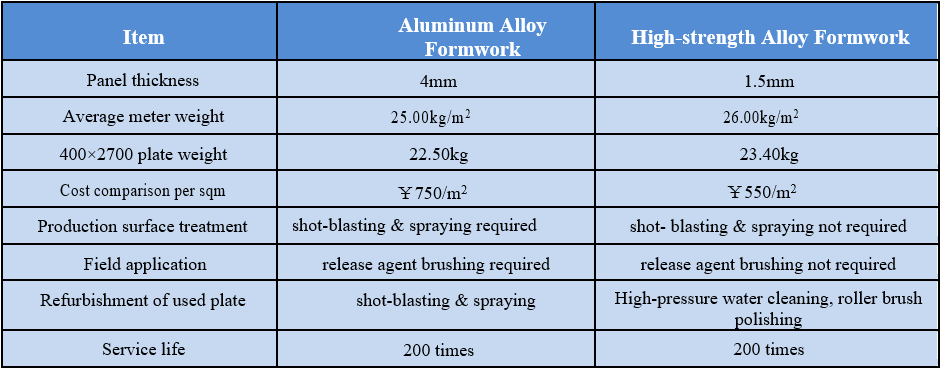
Comparison of High-strength Alloy Formwork with Aluminum Alloy Formwork and Wood Formwork
1. Normally, aluminum alloy material is about 30~40 % more expensive than stainless material.
2. In construction process, release agent must be used to prevent concrete sticking to aluminum alloy formwork due to the reaction between them. In rainy south, release agent is often washed down by rainwater, resulting in serious sticking between concrete and formwork. The weak reaction between concrete and high-strength alloy formwork makes it possible to brush release agent every two or three layers.
3. Compared with aluminum alloy formwork, high-strength alloy formwork avoids the problem of edge cracks occurred in the construction process, and the possibility of return to factory service is greatly reduced.
4. The concrete on aluminum alloy formworks need to be cleaned manually when sent back to factory for refurbishment, which usually cause serious noise pollution; while the cleaning for high-strength alloy formwork can be conducted just by vibrating machine, making the refurbishment cost 40% lower than that of aluminum formwork, even 5~8% lower than production of new ones.
5. After a project is finished, standard high-strength alloy formworks can be transferred directly to another project after being treated by a small cleaning machine.
6. The weight of high-strength alloy formwork is about 0.9kg heavier than that of aluminum one. For example, 2700×400mm formwork weights 23.40 kg, 21.66 kg/m2; while 1200×400mm one weights 11.00kg, 23.00kg/m2.
7. Average ratio of residual value is equal.
Performance Indexes of High-Strength Alloy Formwork, Aluminum Formwork and Wood Formwork
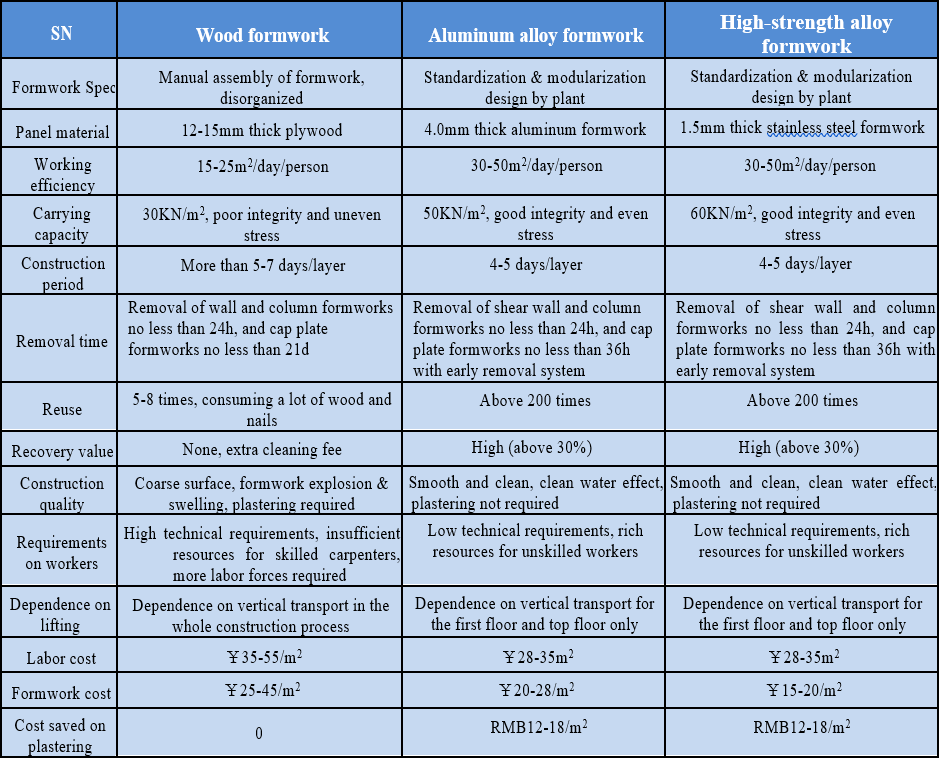
Note: the above data for 30-floor building is used as a reference only, and specific data should be based on actual project analysis
High-strength Alloy Formwork System
Currently, there are two kinds of aluminum formwork system in domestic construction market, one is “through-wall screw system”, and the other is “pair-pulling system”, with the latter first applied by Shoulu Group, a participating unit of local industry standards. Sichuan Shoulu Group developed the high-strength alloy formwork through long-term R&D, which is perfectly compatible with the “through-wall screw system” and “pair-pulling system” of aluminum alloy formwork.
Production Technology & Advantages
1. Compared with other manufacturers, who usually adopt cutting+welding technology to shape purchased section bar, Shoulu uses exclusive-patented extruding machine that adopts full molding technology to produce high-strength alloy formwork. The turnover rate of full molding technology is higher than that of traditional welding technology.
2. High-strength alloy formwork possess features of high corrosion-resistance, smooth surface, high hardness, carrying capacity as high as 60KN/m2, easy demolding and good appearance of finished products.
3. With features of high flatness, long service life and high turnover rate, stainless steel formwork can be used with aluminum alloy formwork.
4. Manual assembly is simple and flexible, making construction speed fast. Easy assembly and quick removal, high working efficiency, release agent not required.
5. Since the construction quality can reach the standard of fair-faced concrete, there’s no need to plaster and scrape, thus effectively reducing overall decoration costs, and also preventing wall cracks and leakage problems thereafter.
6. With one set of formwork+three sets of support system, early removal of formwork (each layer can save 1~2 days) greatly saves material, increases turnover rate and accelerates the construction progress. Manually delivering formwork and support through reserved openings layer by layer can reduce labor intensity, assembly & disassembly costs and transportation cost.
Currently, the dominant position of wood formwork in construction industry is being replaced by a pattern with co-existence of multiple formworks, given that the projects adopting wood formwork are gradually declining in China. Though the market share of high-strength alloy formwork is still very low in current stage, its advantages such as energy saving, environmental friendly, good performance and low raw material cost are obvious. Though it has not been widely recognized by the market yet, its great market potential surely will be stimulated as long as publicity and promotion are put in place. What's more, such a transformation can make contributions to cut industry overcapacity and create new economic growth points for the country.
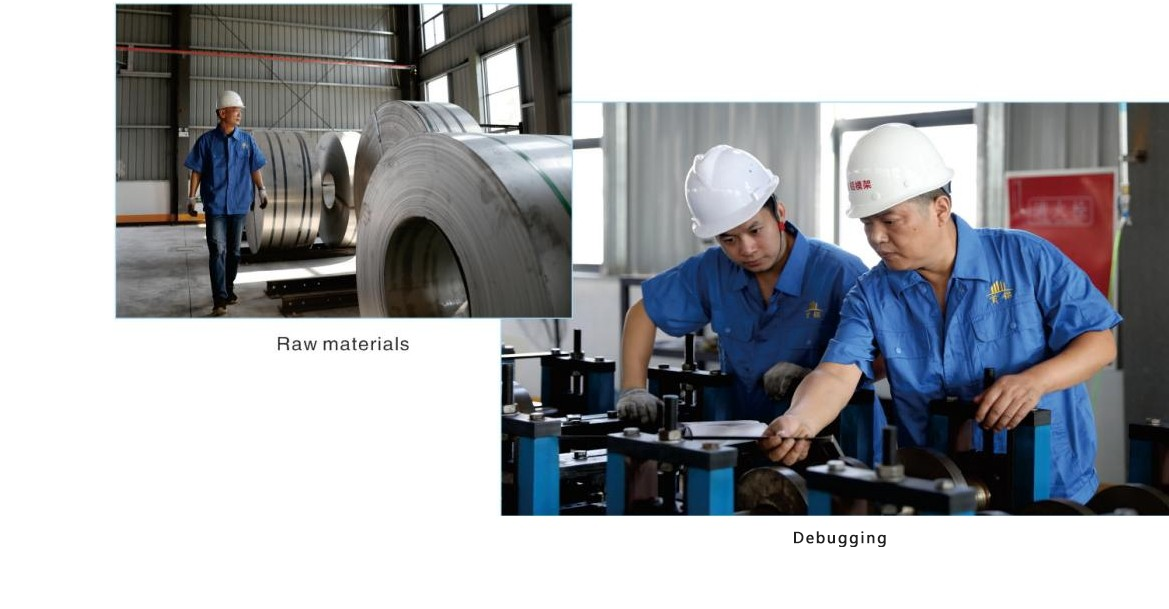
Production Process of High-strength Alloy Formwork

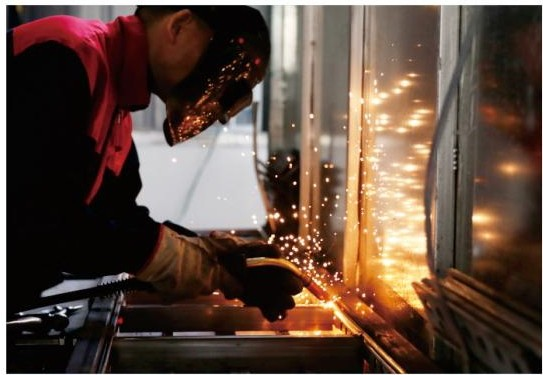
Forming Welding
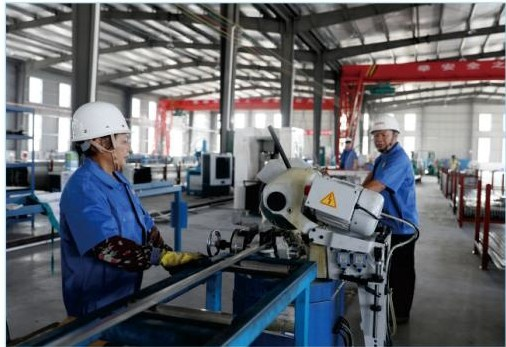

Pipe Cutting Programming on Welding Robot
Effect Analysis on High-strength Alloy Formwork
As for pull-type reinforcement system and screw-type reinforcement system, each has advantages and disadvantages in practical application, which are as follows.
The Advantages of Pull-type System over Screw-type System
1. With lighter grip and square hollow section, the pull-type reinforcement system can greatly reduce the labor intensity of installation workers. Furthermore, the self-weight of parts & components is lighter than that of screw-type reinforcement system, which makes it easy to control verticality.
2. Adoption of disposable pull piece makes it unnecessary to install plastic sheath. Workers only need to use special tools to cut off both ends of pull piece after removal of the formwork, which not only saves the cost of hole filling thereafter, but also easy to ensure the waterproof quality of wall. However, the consumption of pull piece could be large.
3. The pull piece adopted by pull-type reinforcement system has two installation holes reserved at both ends, which results in small size error when connected with formwork, thus easier to ensure the wall thickness.
4. Since less parts & components are used in the pull-type reinforcement system, the self-weight is lighter, which makes it faster to remove formworks.
The Advantages of Screw-type System over Pull-type System
1. The screw-type reinforcement system is more similar to the traditional wood formwork reinforcement system, which is highly recognized by workers and easy to get started with.
2. Since the strength, stiffness and stability of screw- type reinforcement system are higher than those of pull-type system, wall smoothness is better.
3. The screw-type reinforcement system is more convenient for the construction of bay window, drop plates and special-shaped structures.
4. The screw-type reinforcement system has low requirements on construction plane. It’s easy for screw to go through reinforced wall, and can be properly adjusted without touching its position.
With the continuous improvement and innovation of domestic formwork technology, it’s become a very important construction method to improve construction quality and accelerate construction progress. The traditional construction industry is transforming to the trend of "environmental friendly, high efficiency, high quality, fast". High-strength alloy formwork has the same advantage as aluminum alloy formwork on performance. However, lower raw material cost could be a better choice for aluminum formwork manufacturers and general contractors.
Installation Process of High-strength Alloy Formwork
Overall Process Flow
1. Installation process: set out control line→bind spacer bar and wall column rebar→install formwork on one side→install casing and pull piece/split bolt→install formwork on the other side→install beam & plate formwork→install and fasten dorsal bar→check elevation, verticality and flatness→install surface bar and reserved & embedded electromechanical→concrete pouring & curing
2. Removal process: approval of formwork removal→removal of dorsal bar→removal of bolt (screw-type system) →removal of wall column formwork and beam side formwork→removal of positioning rubber cup (screw-type system)→removal of pull piece (pull-type system) →removal of support system→acceptance of concrete quality
Pull-type Reinforcement System
1. Mainly adopts standard stainless steel formwork of 2700×400×1.5mm, which is connected by pins, with components mainly dowel/pins, dorsal bars/buckles, pull pieces and support system, etc.
2. The formworks on both sides of wall should be pulled with 2mm thick pull-pieces, which are connected with the formwork by pins. Five pull-pieces are set on the inner wall, the first one is 150mm above the ground, the others are 300mm apart, and the top one is 600mm apart. One extra pull-piece is set on the outer wall. The dorsal bar is made of rectangular square steel of 50×50×2.5mm. The outer wall is made of 5 dorsal bars, while the inner wall is made of 4 dorsal bars, both of which are double-sided installation. The first dorsal bar is 150mm above the ground.
Screw-type Reinforcement System
1. Mainly adopts standard stainless steel formwork of 2700×400×1.5mm, which is connected by pins, with components mainly dowel/pins, dorsal bars, rubber cups, rubber sleeves, cement braces, M18 split bolts, nuts, gaskets and support system, etc.
2. The formworks on both sides of wall are reinforced with M18 split bolts and dorsal bars of double square steel. The horizontal spacing of split bolts is no more than 900mm, and the dorsal bar is connected by welding two pieces of 40×40×2.5mm rectangular square steel. There are 4 dorsal bars set on the wall, with the first one 150mm above the ground.
High Formwork Support System
Floor height above 3.3m is generally called “High-formwork support” early removal system. To improve the stability of support waist, disc-type reinforcement system need to be welded at the reasonable position of lower & upper pipes supported by independent steel support. After roof pouring is completed, horizontal connecting rod is removed before removal of wall formwork, which makes transverse and vertical delivery of formwork more convenient without the necessity to remove vertical rod. “High-formwork support” early removal system is suitable for office buildings and large public projects.
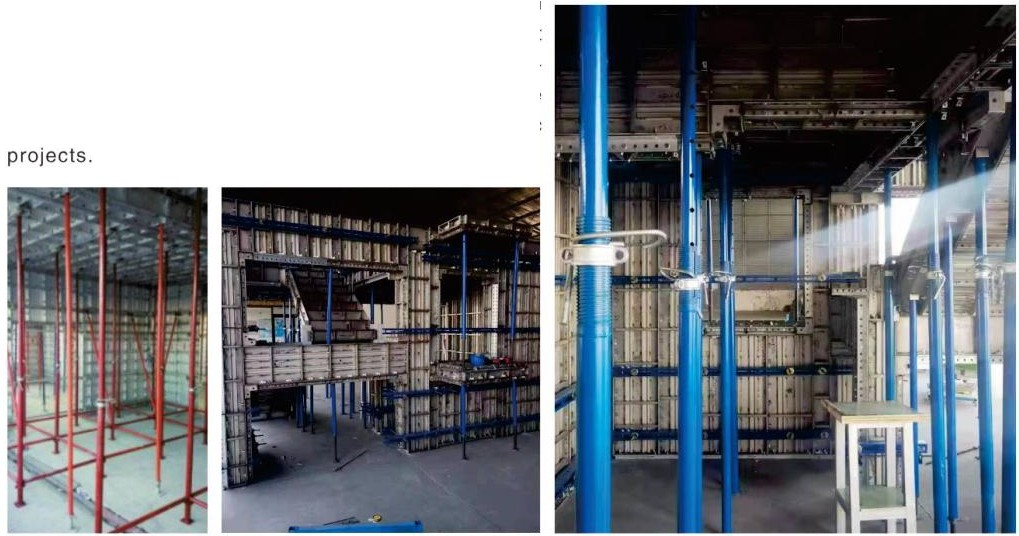
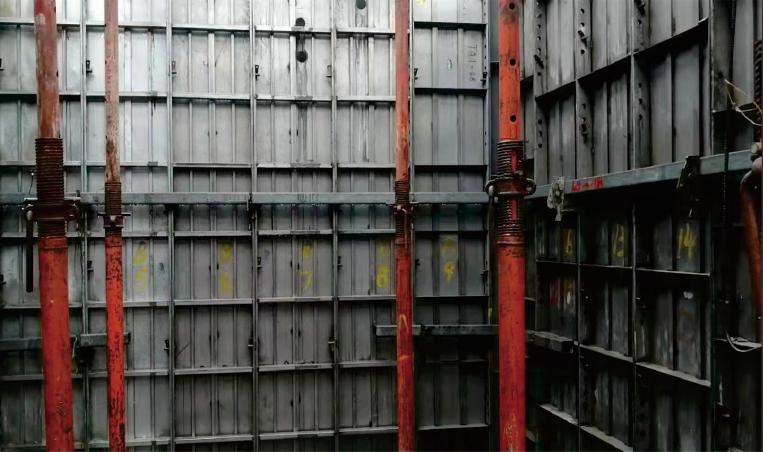
Construction Process
Management of High-strength Alloy Formwork Construction Process

Reinforced triangular diagonal brace, easy to use and reliable, can avoid the leakage problems through bolt hole
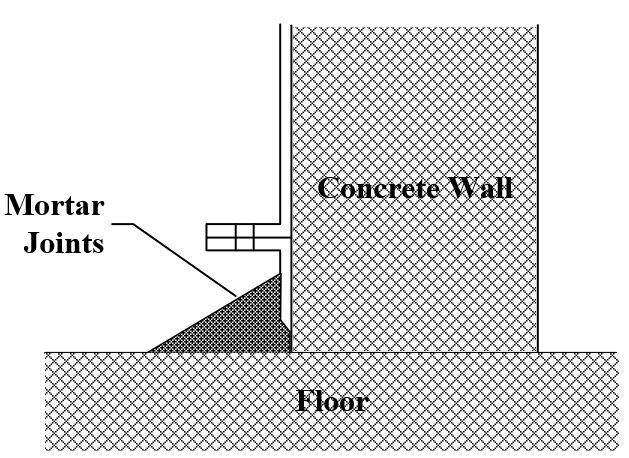
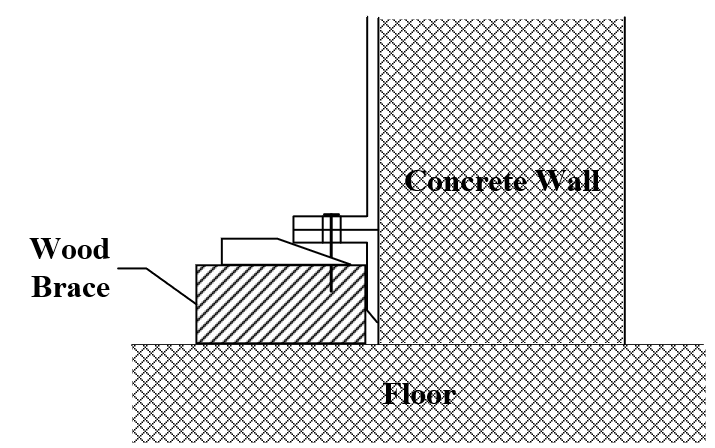
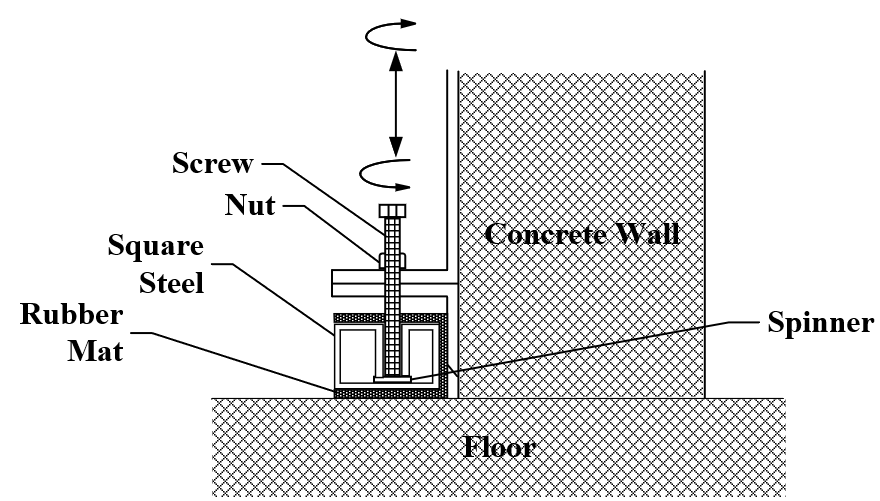
Optimization on strip-filling at the bottom of high-strength alloy formwork

Drawings of Deepened Formwork Design
Deepening the Core Idea of Design, Solidifying Design and Boosting Thorough Design in One Step
Two Belts, Two Points and Two Measures
Two Belts: around doors and windows (stack, platform, beam);
Part of brick wall (inner & outer short-leg brick wall, outer brick wall and lines)
Two Points: plaster-free node (groove at the juncture of brick & concrete);
Anti- leakage node (groove around window frame, railings, iron sheet notch of doors and windows)
Two Measures: load reduction measures (secondary structure optimized to primary structure);
Isolation measures (positions at which stiffness changes after structural optimization)

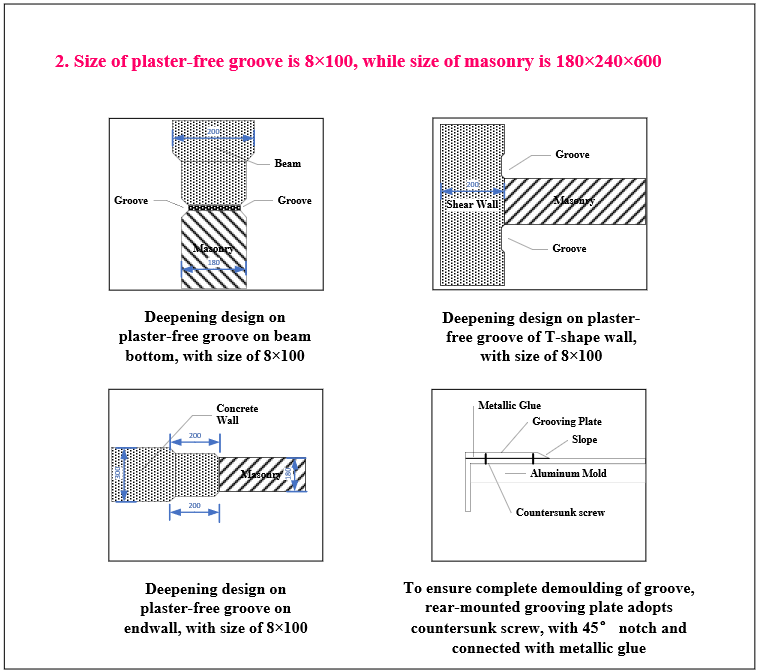
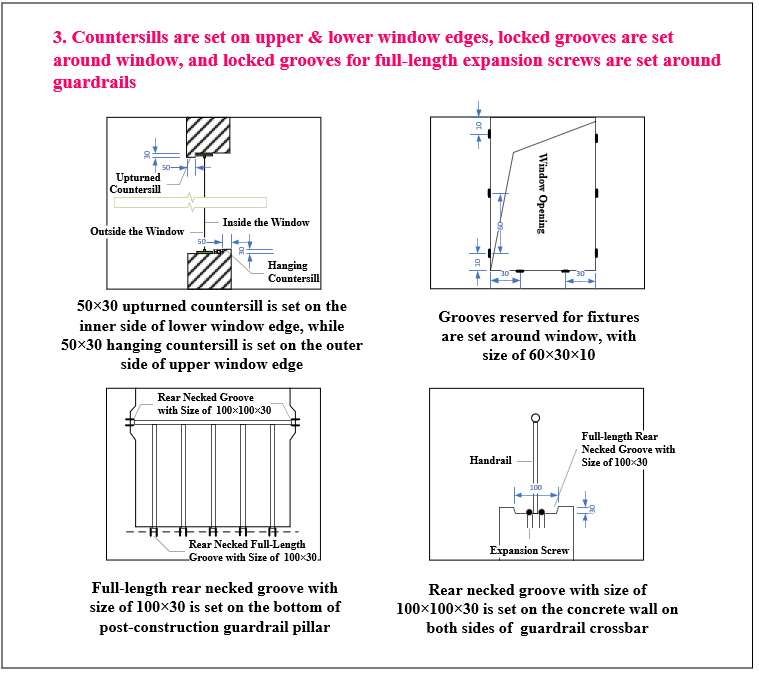
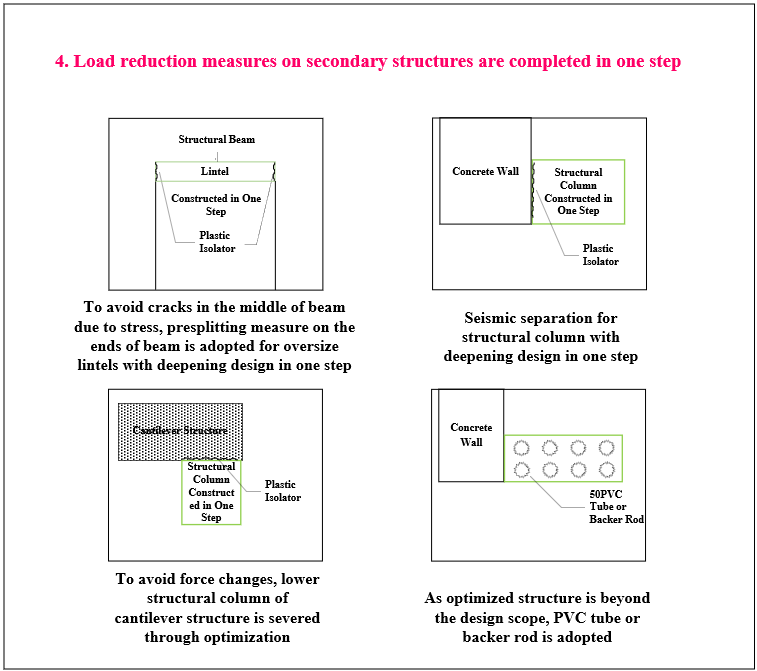
Construction Cases


Our Partners
- China Construction 1st Bureau (Group) Co., Ltd.
- China Construction 2nd Engineering Bureau Co., Ltd.
- China Construction 3rd Group Co., Ltd.
- China Construction 4th Engineering Bureau Co., Ltd.
- Beijing 5th Construction Engineering Group Co., Ltd.
- China Construction 5th Engineering Bureau Co., Ltd.
- Beijing Bohai Construction Co., Ltd.
- China Construction 7th Bureau 4th Construction Co., Ltd.
- Beijing Urban Construction Group Co., Ltd.
- China Construction 8th Engineering Bureau Co., Ltd.
- China Railway 3rd Group Co., Ltd.
- Beijing Construction Group Co., Ltd.
- China Railway 5th Group Co., Ltd.
- Beijing Hanjian Group Co., Ltd.
- China Railway 18th Bureau Group Co., Ltd.
- Beijing Urban & Rural Construction Group Co., Ltd.
- Zhongji Construction Group Co., Ltd.
- Zhongtian Construction Group Co., Ltd.
- Beijing Urban Construction North Construction Co., Ltd.
- China Xinxing Construction & Development Co., Ltd.
- Poly Construction Group Co., Ltd.
- 22th Metallurgical Construction Company of China Ltd.
- Hebei Construction Group Co., Ltd.
- Guangdong Tengyue Construction Engineering Co., Ltd.
- Shenyang Tengyue Construction Engineering Co., Ltd.
- Hanzhong Zhucheng Construction Engineering Co., Ltd.
- New Civil Engineering Construction Co., Ltd.
- Changzhou Jintanjianye Labor Service Co., Ltd.
- Hunan Yiyang Taohualun Construction Engineering Co., Ltd.
- Shaanxi Construction Engineering Group Co., Ltd.
Copyright © Apile Foundation Equipment Co., Ltd. 京ICP备12036865号 Powered by www.300.cn Beijing
